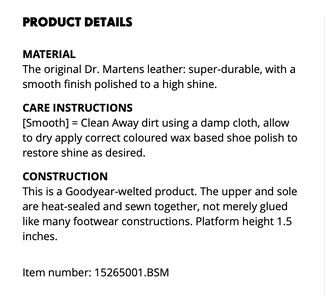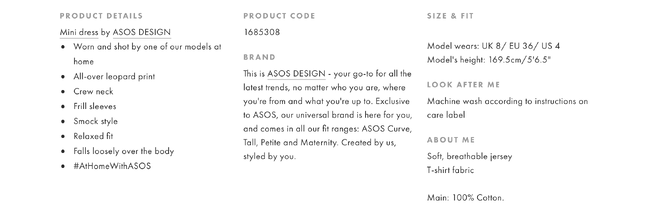Writing product descriptions are often overlooked by entrepreneurs and people who run an eCommerce site but should be considered one of the most crucial marketing tools to compel potential buyers to purchase your products/services.
A product description explains what the product is and why it’s worth purchasing – and should supply customers with important information about the product’s features and benefits, so they are persuaded to buy.
However, many marketers and entrepreneurs alike fall into the common trap of writing product descriptions that simply describe the products. This is a pitfall because a great product description needs to boost your product pages by selling your products to real people, not just acting as back-of-the-box dispenser information for search engines.
Here are seven simple ways you can encourage visitors to your online store with product descriptions that sell.
1. Focus on your ideal buyer
To avoid vague and wishy-washy descriptions that appeal to no one, you should address your target audience directly and personally.
When writing your product descriptions, start by imagining your ideal buyer. What words would he/she use while searching for your product? What words do he/she think are unprofessional? What questions does he/she ask that you should answer?
It can also be helpful to think about how you would speak to your ideal buyer if he/she was purchasing directly in-store face-to-face. It’s important to incorporate that language into your eCommerce product descriptions so they resonate more deeply.
2. Avoid yeah, yeah phrases
Try not to use phrases that act as filler, like “excellent product quality”. When a customer reads something like this, they think yeah, yeah of course; that’s what everyone says.
Using yeah, yeah phrases means your product descriptions become less persuasive. To avoid this reaction, be as specific as possible. Product details add credibility and specific and technical product details sell the product.
Take a look at Platypus Shoes product description for the Dr Martens Jadon boot.
They allude to the high quality of the boots by describing technical details, like “the upper and sole are heat-sealed and sewn together, not merely glued like many footwear constructions.”
3. Appeal to your readers’ imagination
Marketing research has shown that if people hold a product in their hands, their desire to own it increases. However, we’re talking about eCommerce platforms and there’s no way a potential buyer can hold your product until it arrives.
Appealing to your potential buyer’s imagination is one of the best copywriting tricks to employ to increase their desire. Think about writing your product description as if it were a creative writing task. Set a scene and try to place your customer within it, explaining to them how they will feel when owning and using your product.
4. Cut through rational barriers with mini-stories
Stories are a universal language across cultures. A fantastic way to cut through the ‘rational barriers’ built up by customers (understanding that they are being sold to) is to include mini-stories in your product descriptions.
Have a look at UK based Laithwaites which often includes short stories about their wine makers.
“The Dauré family own one of the Roussillon's top properties, the Château de Jau. Around the dinner table one Christmas they agreed it was time to spread their wings and look to new wine horizons. The womenfolk (Las Niñas) fancied Chile and won out in the end, achieving their dream when they established an estate in the Apalta Valley of Colchagua. The terroir is excellent and close neighbours of the Chilean star Montes winery.”
When you are thinking about writing a mini-story for your product description think about; who is making the product, what inspired its creation and how the product was tested.
5. Seduce with sensory words
Restaurants are a great example of boosting sales through sensory language, using words like “velvety”, “smooth”, “crisp” and “bright” to engage the customers and encourage them to use more brain processing power.
Sensory adjectives should evoke all senses, not just sight. Think about how your product sounds, how it feels or how it tastes. However, using adjectives can be difficult – if the adjectives you’ve included in your product description don’t add meaning to what you are trying to sell, you are better off deleting them.
6. Tempt with social proof
Often if a potential buyer is unsure about whether or not to purchase your product, they will look at reviews from other customers. You’re far more likely to purchase a product that has been recommended by a friend or has a great review then not.
Sneaking social proof into your product descriptions is another great copywriting trick to persuade potential buyers. Try including an image of a person alongside their quote as it adds credibility and makes an online company more personable and approachable.
Most buyers are attracted to something that is popular amongst their peers. It’s important then that you highlight products that are ‘favourites’ amongst your customers.
7. Make your description scannable
The layout of your product descriptions is also impertinent in attracting potential buyers. No one wants to scroll through mountains of text that is structurally unsound and confusing.
We really like the product description layout on Asos.com – which includes headings to break up sections of information and clean, simple font.
When writing your product descriptions, keep in mind how your customers will read it on the website. Are the images you’ve used clear and high resolution? Do you have headlines to break down product information? Is there plenty of white space?
Writing compelling and detailed product descriptions will always pay you back. Go ahead and share your knowledge about the product, tell stories and explain the small details. Don’t be boring and tempt your potential buyers with sensory descriptions.
Even more
For more information about writing good product descriptions visit 3 Colts article - 10 ways to write product descriptions that sell
(Paraphrased from Shopify blog)




